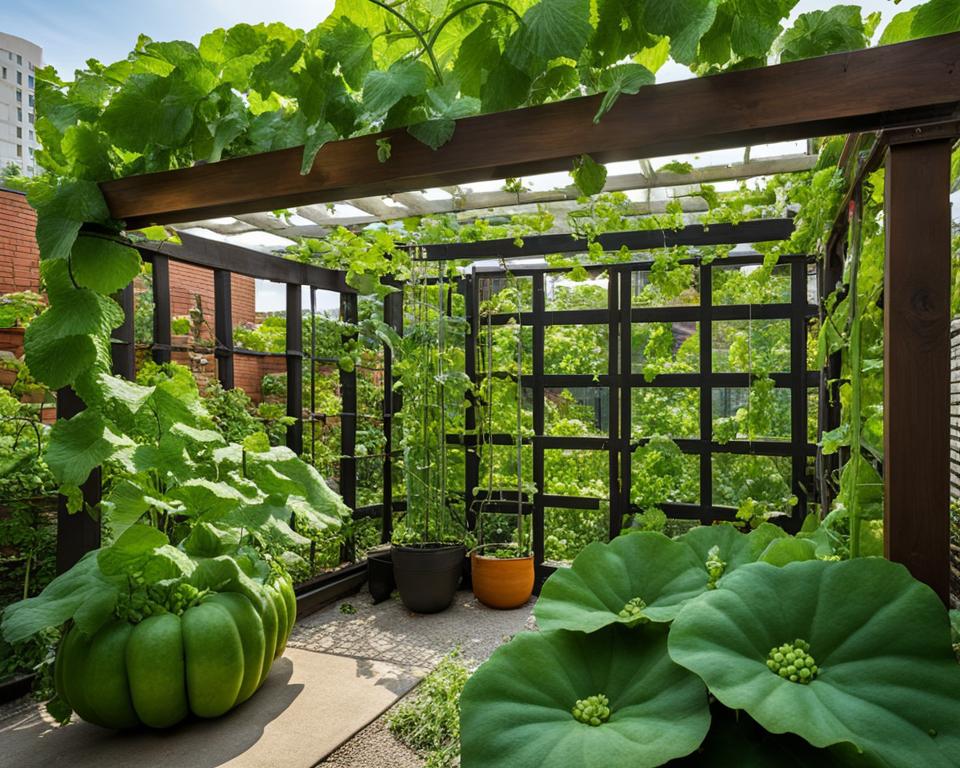Welcome to the world of vertical squash gardening! This revolutionary approach to gardening is perfect for those who want to make the most out of limited space, especially in urban environments. Vertical squash gardening not only saves square footage, it allows your sustainable and resourceful garden to produce more than you thought possible. In this guide, we’ll explore how growing squash vertically can transform your garden into a high-yielding, beautiful, and accessible haven for urban gardening enthusiasts.
Key Takeaways
- Vertical squash gardening maximizes garden productivity, even in limited spaces.
- This form of gardening is a sustainable and resourceful approach to cultivating squash.
- Vertical gardens are perfect for urban areas with limited outdoor space.
- Growing squash vertically can increase yields and enhance the aesthetic appeal of your garden.
- Vertical squash gardens are accessible, making them convenient for gardeners of all abilities.
Understanding Vertical Squash Gardening Benefits
Vertical squash gardening offers numerous advantages, particularly for urban dwellers and those with limited garden space. By growing your squash vertically, you can harness the full potential of your available garden area, both in terms of aesthetics and yield. Let’s explore the many benefits of this innovative gardening practice.
The Convenience of Small Space Gardening
When you have limited gardening space, you need to make every inch count. Vertical vegetable gardening allows you to use your garden’s wall space or fences to grow a lush squash garden efficiently. No matter how confined your outdoor area may be, vertical squash cultivation can help transform it into a productive and inviting garden oasis. Additionally, by employing creative gardening solutions like stacking raised beds or installing hanging planters, you can further optimize your small space garden layout.
Boosting Squash Yields in Urban Settings
One may assume that limited gardening space would hinder the number of vegetables you can produce. However, the higher planting density provided by vertical gardening can potentially lead to a higher yield of squash per square foot. By utilizing specially designed structures like trellises or pergolas, you can help your squash plants climb more efficiently and reduce the risk of diseases caused by poor air circulation. Vertical gardening techniques can also offer better sun exposure for your squash plants, leading to healthier and more abundant harvests.
Enhancing Aesthetic Appeal and Accessibility
Beyond the practical benefits, vertical squash gardening also allows for striking and innovative garden designs that can improve the overall appearance of your urban space. An aesthetically designed vertical garden serves as an attractive focal point, adding unique visual interest to your garden setting. Additionally, vertical vegetable gardening enables easier access to your plants for maintenance and harvesting, as the plants’ accessible height reduces the need for bending over or kneeling.
“Vertical gardening not only makes the most of limited space, but it also adds an attractive and lively touch to urban landscapes while promoting sustainable vegetable cultivation.”
By incorporating vertical squash gardening techniques into your small space garden, you’ll reap the benefits of increased squash yields, improved aesthetics, and more accessible gardening. Combine these vegetable gardening tips with a well-thought-out garden design to create a lush, productive, and visually appealing urban garden that you’ll be proud to showcase.
Selecting the Right Squash Varieties for Vertical Cultivation
Choosing the appropriate squash varieties is a critical step when it comes to vertical gardening. The squash family is vast and diverse, but not all types will thrive when grown vertically. In general, vining squash varieties are more suitable for vertical growth, while bush-type squash has a compact growth habit that may not be ideal for climbing.
Here are some popular vining squash varieties that are known to perform well in vertical gardens:
- Butternut squash
- Spaghetti squash
- Tromboncino
- Delicata squash
- Table Queen Acorn squash
When selecting your squash plants or seeds, keep the following tips in mind:
- Choose vining rather than bush-type squash: Vining varieties are more likely to thrive in a vertical setup because they naturally climb and produce long vines.
- Consider disease resistance: Look for squash varieties with built-in resistance to common diseases, such as powdery mildew, as this can improve their chances of success in a vertical garden.
- Think about fruit size and weight: Varieties that produce smaller and lighter squash will be easier to manage on a trellis or support system.
- Opt for high-yielding varieties: Some squash varieties, like butternut and spaghetti squash, are known for being prolific producers, making them an ideal choice for vertical gardening.
“Choose vining, high-yielding squash varieties that are resistant to common diseases and produce smaller, lighter fruits for successful vertical cultivation.”
Selecting the right squash varieties for your vertical garden not only ensures your plants will thrive, but it also helps you make the most of your limited gardening space. By considering these factors, you’ll be well on your way to successfully growing squash vertically and enjoying a bountiful harvest.
Essential Equipment for Setting Up Your Vertical Garden
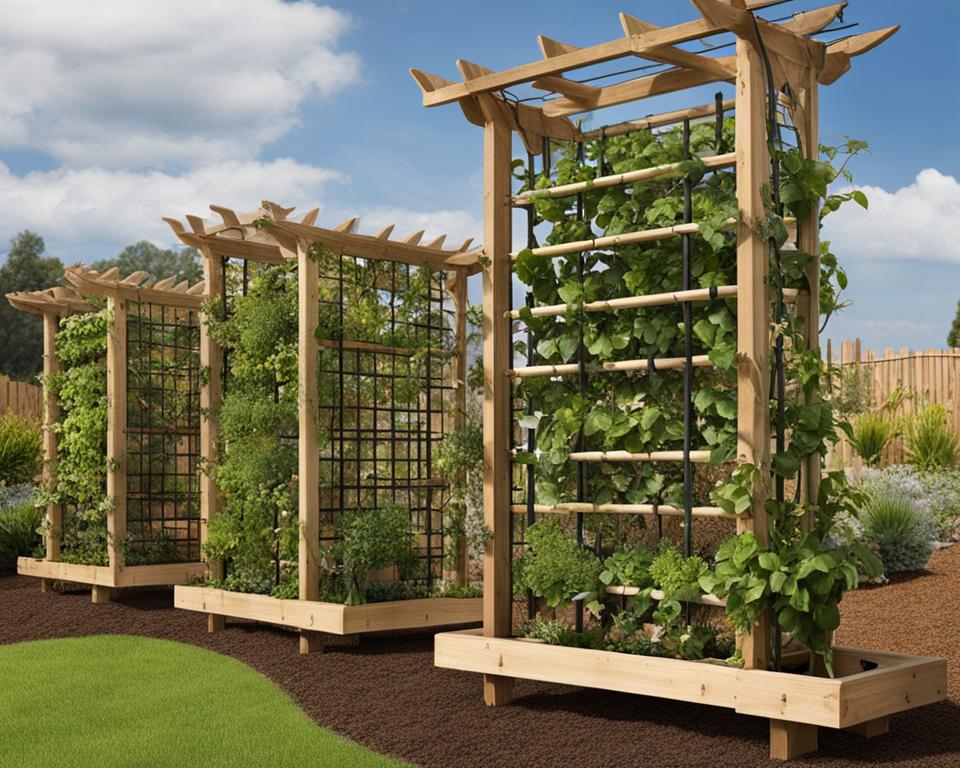
Gearing up with the right equipment is crucial to successfully set up your vertical garden for squash cultivation. In this section, you will discover the importance of sturdy trellises and gardening supports, and the factors to consider when selecting gardening containers for your squash plants.
Sturdy Trellises and Supports
Squash plants can become quite heavy as they grow, so it’s essential to choose durable and robust trellises and supports to bear their weight. There are a variety of options available, ranging from metal to wooden trellises, as well as different designs for your vertical installations. Consider these popular types of sturdy trellises for your garden:
- A-frame trellis
- Arch or arbor trellis
- Cucumber trellis
- Fan trellis
- Ladder trellis
Tip: Choose trellises and supports that are easy to assemble and disassemble so you can move them around or store them during the off-season.
Ensure that your chosen trellis has adequate spacing between the rungs to accommodate the growth of your squash plants. Additionally, it must be tall enough for the particular squash variety you’re growing.
Choosing Containers for Vertical Installations
As a vital component of a successful vertical garden, your choice in gardening containers should be carefully considered. When it comes to container gardening, factors like size, material, drainage, and weight play a role in a flourishing squash garden. Here are some tips to help you select the perfect containers:
- Opt for a container size that can accommodate the mature size of your squash plants. A general rule of thumb is to provide at least 5 gallons of soil per plant.
- Choose containers made from materials like plastic, fiberglass, or fabric, as they retain moisture better than clay or ceramic pots and are lighter in weight, making them ideal for vertical installations.
- Ensure your selected containers have proper drainage holes to prevent waterlogging and root rot.
- When possible, select self-watering containers to simplify the task of maintaining optimal moisture levels.
Remember,
the combination of sturdy trellises and appropriate gardening containers can significantly improve your squash plants’ growth and overall health. By investing in the proper equipment, you will be one step closer to a successful and bountiful vertical squash garden.
Soil and Nutrient Requirements for Thriving Squash Plants
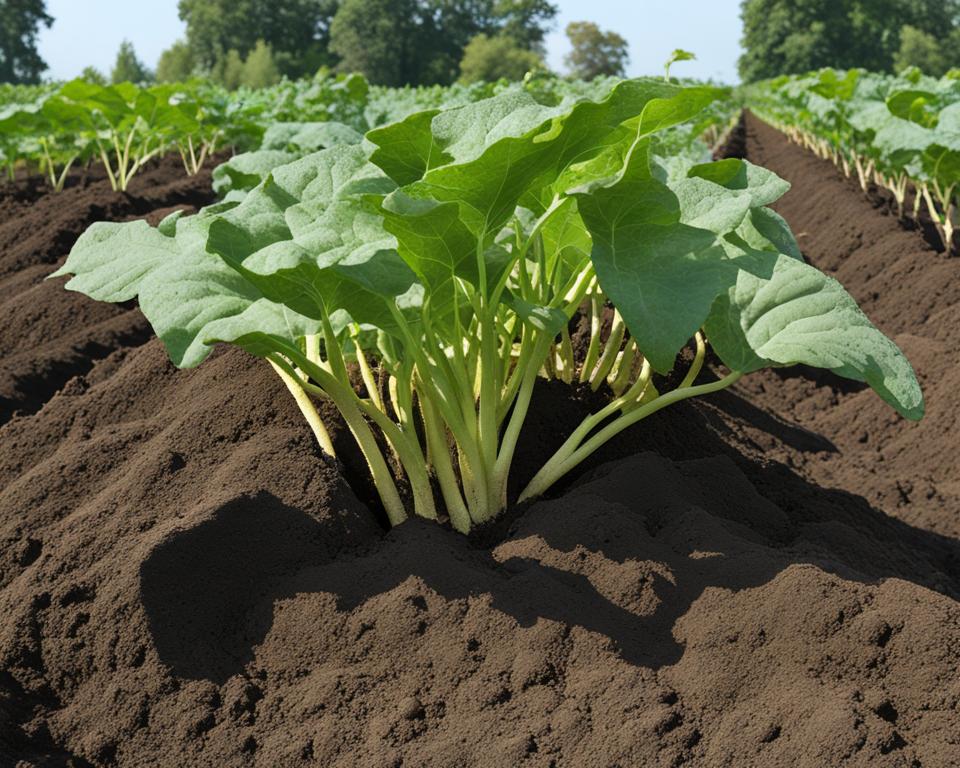
The foundation of a successful vertical squash garden lies in the quality of soil and the nutrients it provides to the plants. To optimize the growth and yield of your squash, it is essential to carefully prepare the soil mixture and incorporate organic matter to maintain healthy soil conditions.
Matching nutrient requirements with appropriate soil amendments will not only ensure your squash plants flourish but also contribute to sustainable gardening by making efficient use of resources and promoting a healthy ecosystem.
Creating the Perfect Soil Mixture
Begin by selecting the best soil mixture that caters to the needs of squash plants. The ideal soil should be well-draining, yet retain sufficient moisture to support the growth of your squash plants. A mixture of equal parts compost, peat moss, and coarse sand will provide excellent drainage and aeration, along with adequate water retention and essential nutrients.
Recommended soil mixture: 1/3 compost, 1/3 peat moss, and 1/3 coarse sand
Incorporating Organic Matter
Enriching the soil with organic matter plays a pivotal role in organic gardening, as it helps improve soil structure, enhances fertility, and encourages beneficial microorganism activity. Compost, aged animal manure, and dried leaves are all excellent choices for organic amendments.
- Choose a source of organic matter suitable for your garden setup.
- Ensure the organic matter is aged and fully decomposed before incorporating it.
- Thoroughly mix the organic matter with the initial soil mixture to create a homogenous blend.
Essential Nutrients for Squash Plants
Squash plants require essential nutrients to thrive, especially nitrogen, phosphorous, and potassium. These macronutrients are often referred to as N-P-K, and they play a significant role in plant growth. Here are some organic sources of these vital nutrients:
| Nutrient | Organic Source |
|---|---|
| Nitrogen (N) | Alfalfa meal, blood meal, or aged chicken manure |
| Phosphorous (P) | Bone meal or rock phosphate |
| Potassium (K) | Green sand or wood ashes |
Maintaining soil quality and meeting nutrient requirements are key factors in ensuring a successful vertical squash garden. By following these guidelines and choosing the right soil mixture, organic matter, and nutrient sources, you will create the ideal growing environment for thriving squash plants.
Planting Techniques for a Vertical Squash Garden
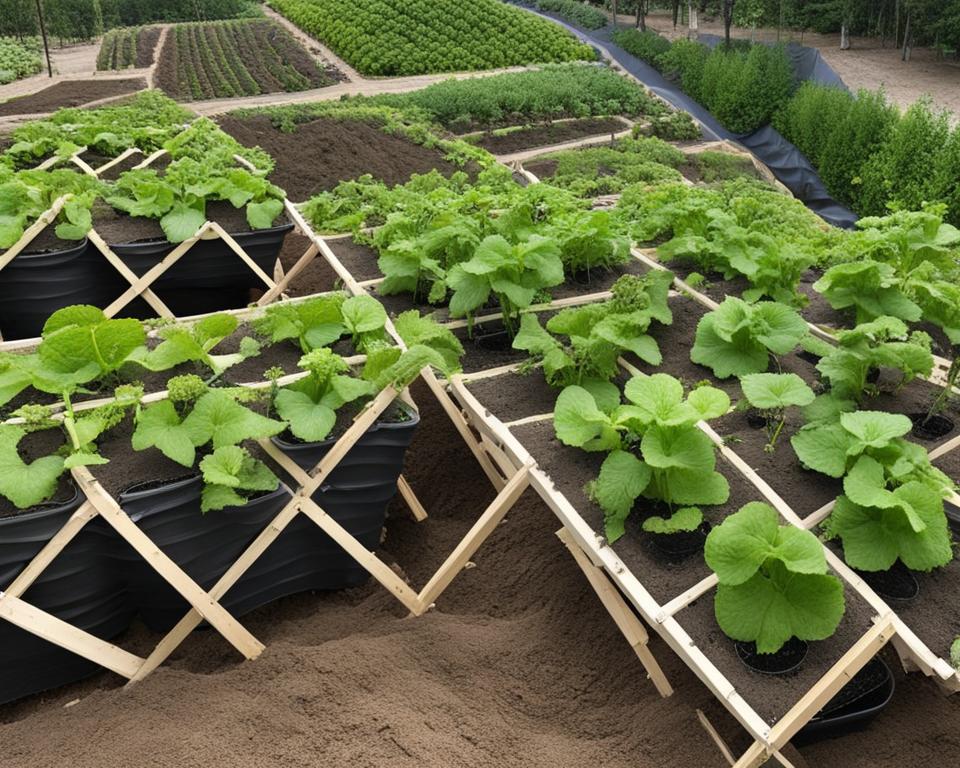
Creating a successful and bountiful vertical squash garden starts with mastering the proper planting techniques. Vertical vegetable gardening offers a unique opportunity to utilize the available space efficiently, grow more squash in a limited area, and follow some simple, effective gardening tips to ensure healthy growth. In this section, we’ll provide you with essential guidelines on spacing, depth, and orientation for planting squash in your vertical garden.
Proper spacing is crucial for allowing squash plants to grow and climb without competing for essential nutrients, light, and air circulation. Generally, seeds should be planted at a distance of 18-24 inches apart within a row or container. Trailing varieties require even larger spacing of about 36-48 inches to accommodate their extensive growth. This spacing encourages optimal growth and minimizes the chances of diseases and pest infestations.
Remember to consider the weight and size of the fully grown squash when selecting and designing your vertical support structures. Your trellis or support needs to handle the plant’s growth without collapsing under pressure. Assess and estimate the plant’s requirements and plan accordingly.
Planting depth is another significant factor when establishing your vertical squash garden. Generally, seeds should be planted about 1-1.5 inches deep. When transplanting seedlings, make sure the soil level of the new container matches the original soil level around the seedling to maintain the right depth.
Lastly, orientation plays a vital role in ensuring successful plant growth. Squash plants love sunshine, so position your trellis or support structure in a way that maximizes sunlight exposure. The number of daily sunlight hours your plants receive should be between 6 and 8 hours. When using containers, place them on the sunnier side of the support structure.
Staggered Planting: A Technique for Extended Harvesting
Staggered planting, also known as succession planting, is a popular technique for extending the harvesting season. This approach involves planting new seeds or seedlings every two to three weeks.
- Begin by planting a set number of seeds or seedlings at the proper spacing and depth.
- Two to three weeks later, plant another set of seeds or seedlings, following the same spacing and depth guidelines.
- Continue this process for a few months or until you reach the desired number of plants.
This planting method helps gardeners enjoy a continuous harvest of fresh squash for an extended period, as older plants keep producing while younger plants start to develop.
| Planting Technique | Key Points |
|---|---|
| Spacing | 18-24 inches between plants, 36-48 inches for trailing varieties |
| Depth | 1-1.5 inches for seeds, match original soil level for transplanting seedlings |
| Orientation | Maximize sunlight exposure, 6-8 hours of daily sunlight |
| Staggered Planting | Plant new seeds or seedlings every 2-3 weeks for an extended harvest |
By carefully following these planting techniques, you can optimize your vertical squash garden for fruitful cultivation. In the upcoming sections, we’ll dive deeper into other essential aspects of vertical vegetable gardening, such as watering systems, pest management, and harvesting techniques.
Watering Systems for Efficient Vertical Gardening
Choosing the right watering system is crucial for successful vertical squash gardening. The key is to find a watering method that provides adequate and even hydration to your plants while minimizing the use of water resources. In this section, we will discuss two popular watering systems for vertical gardens: drip irrigation and manual watering methods.
Drip Irrigation vs. Manual Watering Methods
Drip irrigation and manual watering methods each come with their unique advantages and drawbacks. Here, we’ll provide a brief overview of both systems to help you decide which option is best suited for your vertical squash garden.
Remember, the primary goal is to ensure proper hydration for your climbing squash plants while promoting efficient water usage in your vertical garden.
| Watering System | Pros | Cons |
|---|---|---|
| Drip Irrigation |
|
|
| Manual Watering (hose, watering can, or spray bottle) |
|
|
Both watering systems can be utilized effectively in a vertical gardening setup, but the choice ultimately depends on your preferences, budget, and the size of your garden. Drip irrigation may be more suitable for individuals with limited time and a focus on water efficiency, while manual watering methods provide greater control and flexibility for those with smaller gardens or a tighter budget.
In conclusion, selecting the best watering system for your vertical squash garden involves weighing the pros and cons of each method, considering your garden’s specific needs, and prioritizing water efficiency. A well-hydrated squash plant will thrive in your vertical garden, providing a bountiful harvest and a sustainable gardening experience.
Pest Management and Organic Care in Squash Cultivation
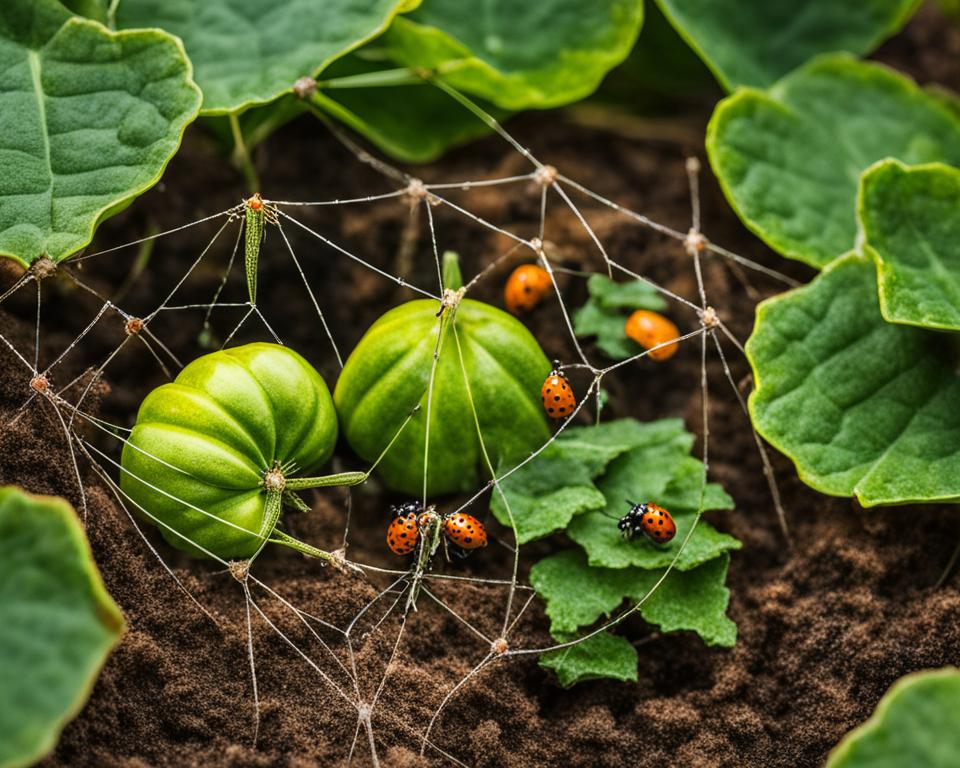
Pests can pose a significant threat to the success of your squash plants in a vertical garden. Implementing environmentally friendly pest management practices and using organic gardening techniques can provide your plants with protection and sustenance without harming the environment. Here, we discuss several common pests that affect squash cultivation and outline organic solutions for preventing and treating infestations.
| Pest | Description | Organic Prevention Methods | Organic Treatment Options |
|---|---|---|---|
| Squash Bugs | Greyish-brown insects that feed on squash leaves, causing them to wilt and turn brown. |
|
|
| Squash Vine Borers | Larvae that bore into squash stems, causing wilting and potentially killing the plant. |
|
|
| Aphids | Small, soft-bodied insects that suck sap from leaves, causing leaf curling and yellowing. |
|
|
In addition to these organic pest management techniques, maintaining proper plant health through adequate watering, soil nutrient content, and sunlight exposure can create an environment that deters pests. Finally, always remove and dispose of any affected plants to prevent pests from spreading to other plants in your vertical garden.
Maintaining a healthy, organic vertical squash garden is achievable with effective pest management
. By using environmentally friendly practices and actively monitoring your garden for signs of infestations, you can protect your squash plants and enjoy a bountiful harvest.
Harvesting and Storing Your Squash from a Vertical Garden
As your vertical garden flourishes, it’s essential to know when and how to harvest your squash. This section will guide you on determining the perfect timing for harvesting your squash from a vertical garden, as well as the best methods for maintaining post-harvest freshness for longer.
Knowing When Your Squash is Ready to Harvest
Harvesting squash at the right time ensures optimal flavor and nutritional value. Here are some tips to help you determine when your squash is ready for harvest:
- Size: Pay attention to the size of your squash. Generally, it’s best to harvest when the squash is small and tender.
- Color: The color of the squash can give you an indication of ripeness. Squash should have a deep, even color and a glossy sheen.
- Texture: Gently press the surface of the squash to assess its firmness. The skin should be hard and resist puncturing when you press it with your thumb or thumbnail.
- Stem: A dry, brown stem where it connects to the squash is a good indication that it’s ripe and ready to harvest.
Tip: Harvesting squash early in the morning can help preserve its quality and maximize post-harvest freshness.
Best Practices for Prolonging Squash Freshness Post-Harvest
To enjoy your harvest for as long as possible, follow these storage tips:
- Handle with care: Be gentle when harvesting and handling your squash to prevent bruising, scratches, or punctures, which can shorten the storage life. Use clean and sharp scissors or pruners to cut the squash from the vine, leaving a short stub of the stem attached.
- Proper storage conditions: Store your freshly harvested squash in a cool, dry, and well-ventilated area, away from direct sunlight. Ideal storage temperatures range between 50-60°F (10-15°C) for most squash varieties.
- Avoid overcrowding: To ensure proper airflow and to prevent the spread of decay, avoid stacking the squash on top of one another.
- Monitor regularly: Check your stored squash regularly for signs of spoilage or decay and remove any affected squash immediately to prolong the overall storage life.
By employing these harvesting and storage techniques, you’ll maintain the quality and freshness of your squash for longer, enabling you to enjoy your vertical gardening harvest even more.
Embrace Vertical Squash Gardening for Sustainable Urban Living
Vertical squash gardening is a highly efficient and sustainable approach to urban gardening that holds a myriad of benefits. By embracing this innovative method, you can overcome space constraints and grow an abundance of squash in even the smallest of areas. The numerous advantages of vertical squash gardening are clear – it allows for optimized productivity, provides aesthetic appeal, and offers accessibility for maintenance and harvest.
Throughout this article, we have covered essential gardening tips for selecting suitable squash varieties, setting up your vertical garden with sturdy supports and containers, and ensuring proper soil preparation and nutrient management. We’ve also discussed planting techniques, ideal watering systems for vertical growing, organic pest management, and harvesting and storing your bountiful squash yield.
As an urban gardener, implementing these vertical squash gardening tips and techniques will not only enable you to make the best use of your limited space but also contribute to an environmentally friendly lifestyle. Get started on your vertical squash gardening journey and experience the joy and satisfaction of growing your own delicious and nutritious food.
FAQ
What is vertical squash gardening?
Vertical squash gardening is a method of cultivating squash plants by allowing them to grow upward on support structures like trellises. This space-saving approach is particularly beneficial for urban gardeners or those with limited space, as it maximizes productivity while minimizing the garden’s footprint.
Can all types of squash be grown vertically?
Vining squash varieties are the most suitable for vertical gardening, while bush-type squash plants may not adapt well to this method. When choosing squash varieties for your vertical garden, look for vining types like pole squash and tromboncino, which are known to thrive in vertical setups.
What type of support structure is best for vertical squash gardening?
Sturdy trellises or supports made of materials like wood, metal, or heavy-duty plastic are ideal for vertical squash gardens. Make sure the support structure can handle the weight and growth habits of the squash plant while providing ample space for the vines to climb and develop.
How do I choose the right container for a vertical squash garden?
When selecting containers for your vertical squash garden, consider factors like size, material, and drainage. Choose containers large enough to accommodate the mature root system of the squash plant and ensure they are made from durable materials that can withstand outdoor weather conditions. Also, verify that the containers have proper drainage holes to prevent waterlogging.
What kind of soil and nutrients do squash plants require in a vertical garden?
Squash plants in a vertical garden require well-draining, nutrient-rich soil. Incorporate organic matter, such as compost or aged manure, and use a balanced fertilizer to provide essential nutrients like nitrogen, phosphorus, and potassium. Maintaining proper soil quality and nutrient levels will promote healthy growth and plentiful harvests.
How do I water my vertical squash garden efficiently?
Drip irrigation and manual watering methods like watering cans or hoses can both be used to water your vertical squash garden efficiently. Consider the advantages and drawbacks of each system, such as the convenience of a hands-off approach provided by drip irrigation versus the controlled application of water offered by manual methods. Regular, even hydration is crucial for successful squash cultivation.
What organic pest management solutions can I use for my vertical squash garden?
To manage pests organically in your vertical squash garden, employ preventative measures like crop rotation and companion planting, and use physical barriers like floating row covers. If needed, apply organic treatments like insecticidal soap or neem oil to control infestations while minimizing harm to the environment.
How do I know when to harvest my squash from a vertical garden?
Monitor your squash plants for visual and tactile clues that indicate ripeness and readiness for harvest. For example, watch for a rich, even color, firm skin, and easily detaching stems. Timing varies based on the specific variety, so consult seed packets or reference guides for the ideal harvest window.
How can I prolong the freshness of my harvested squash?
To prolong the freshness of harvested squash, store it in a cool, dark, and well-ventilated area. Keep in mind that ideal storage conditions may vary depending on the squash variety. Proper storage will help maximize shelf life, allowing you to enjoy your homegrown produce for as long as possible.

